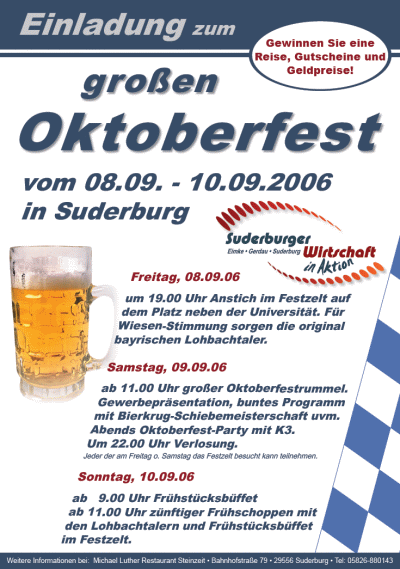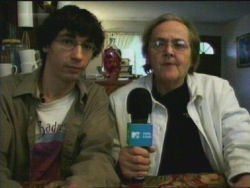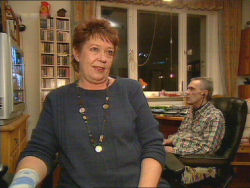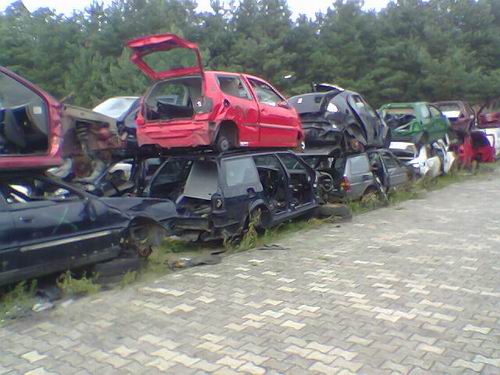….NOT!
And what’s this?
Next weeks blog content. Please stay tuned.
(more?)
…dass wir im NDR Fernsehprogramm (N3) jetzt auch eine “Hitliste des Nordens” haben. Hatten. Kam heute abend im TV.
Für die jüngere Generation: ein “Best of…” ausm Bücherschrank, so ne Art Übersicht der stories die unsere Eltern gelesen und für gut befunden haben und die wir höchstens als Filme kennen. Oder?
Ich sach mal so…. bzw. Sitze ich so Montag abend vor der Glotze, zappe mich durchs Programm und wundere mich, weil ich nicht richtig verstehe, ob ich mich jetzt über die schöne Auswahl der Bücher freuen soll, oder aber über die Tatsache, dass heutzutage für alles Mögliche und Unmögliche Hitlisten erstellt werden?
Deutschland, das Land der Hitlisten-Ersteller und Geschichtsaufarbeitungs-Fanatiker? Was musste ein Schriftsteller vor 50 Jahren vollbringen, um gelesen und für gut befunden zu werden? Und was muss er dafür heutzutage tun, um mit seinen Aussagen nicht in der Masse der Medien unterzugehen?
Interessanterweise standen auf der Hitliste größtenteils die Bücher, deren Thematik sich auch ungefähr mit dem Lebensgefühl und/oder der Denkweise der Leser beschäftigt… = Geschichten als Indifikations-Indikatoren für eine ganze Generation?
Es muss so sein – denn WIR haben schließlich last.fm und andere nette tools, die uns z.B. die am meisten gehörten Musiktitel aufzeigen. Oder dieser eine Bekannte, der sich jedes Jahr eine Zusammenstellung seiner Lieblingslieder auf CD brennt und dann fein säuberlich einordnet. So für später, fürs Archiv.
Insofern scheint das Leben eine einzige Aneinanderreihung von Hitlisten zu sein. Nein wie isses schön…
Some time ago, my dear friend Mr. Burns advised me to install an english operating system (OS) like WinXP on my notebook so that I will have less problems explaining things on it whenever I’d need it for a presentation in an english speaking environment.
Being the typical Geek 1.0, I was first irritated by the idea of installing yet another OS on my beloved machine and didn’t want to spoil the MS-dominated bootsector and other vital parts of my german WinXP version that could be affected by another OS.
And then, again, I keep on forgetting about the two virtual pc environments that have come up in the past and that I and many others have written about. For those who need to know – well, you most prolly already know this, but for the computer beginners, let me just explain this: there is a secure, hassle-free way to have more than one operating system runing on your computer. But why would you want that?
The average Windows user out there installs a few programmes for testing, dislikes them and decides to de-install them again. The deinstallation process though does not cover ALL parts of the previous installations and “forgets” some additional files that are left on the harddisk for eternity (~ until your next installation of Windows). And there are many user-utilities that have no other purpose than cleaning up your messed up installation of Windows and/or lost entries in the Windows-registry (where, as the name suggests, all programmes are registered for use with the operating system). You end up getting a messed up Windows that needs to be re-installed / repaired / etc.. And all this just because you wanted to test this or that small tool you urgently needed to rip-music cds, flash mobile phones, draw a picture in CAD or maybe because you were testing diverse media players that each come with their own setup-installation-routine.
Or in other words: most beginners need to take time to understand which programmes they want to use on their Windows OS and will have a collection of programmes they are going to install after a clean installation of windows.
The solution is to use so-called virtual machines – which are nothing else but virtual environments right on your existing operating system that create a single file into which a whole operating system can be loaded / installed.
Let’s say you want to try out a Linux distribution like the popular Kubuntu 6.06 and already figured you wouldn’t want this to run from a so-called Live CD (= boots from the CD without any installation). Neither are you willing to screw your existing Windows bootsector by installing a Linux Loader tool that gives you the option which OS to start during the boot-up process. And although there’s always a way for the experienced user to solve such problems, what we are looking for are simple, fast and free solutions. After all, all you wanted to do is (safely) testing a piece of software….
Instead, you might be interested in creating a so-called virtual machine. Something that gives you access to a full Linux environment AT THE SAME TIME while you are using Windows XP without restarting/rebooting your computer.
And as I’ve mentioned earlier, there are two choices for that: the MS Virtual PC and VMWare.
The MS Virtual PC (demo) is a free download from MS that enables you to set up a virtual environment on your existing Windows OS. After installation, you are guided through a set up process and open a new virtual pc. A window pops up and you get a black screen, a virtual pc booting a virtual BIOS. From this point onwards, you can install either another MS operating system, or even load a virtual ISO (image file) to install a Linux distribution. Basically anthing that you would also install on your computer from that level.
VMWare offers an alternative for the more professional user – it is able to handle processes in a different way and has much more options. VMWare offers a player (VMWare player) that is able to “play” pre-installed virtual machines (operating systems and aplliances) which can be downloaded from the Virtual Machine Center for free!
And as much as I love the VMWare player, the MS Virtual PC software seems to be adequate enough for my purposes as it provides an english OS at the click of a button. Simple as that! :-)
—–
The other day, I blogged about tools that start right from your very own USB memory stick.
You don’t need to be in a developing country to experience what it means to have restricted access to your own computer. Let’s say you are a traveller and would like to check your e-mail from an internet café somewhere on this planet. You’re lucky you’ve found a free seat and have already gotten over the fact that the guys running the café are ripping you off with the amount you pay per minute surfing. Aaargh….yahoo/hotmail/gmail/etc – the webmailer takes ages to load and opening a single page is a pain. Advertisment banners load first (unless you’re using a prof. webmailer) and you end up paying extra money just for reading and answering your mail. Remember: you’re paying for the amount of time you’re online.
Now, in a country like Kenya, not everyone has his/her own computer. Even less ppl have access to the internet – but USB memory sticks are for sale at a reasonable price. The idea is to make use of USB memory sticks other than just storing personal data. Applications that are installed onto the USB stick and run from it. I know there are already some models out there that come shipped with pre-installed applications, but instead of focusing on the software only, I would still like to point out the benefit you get while using software installed on your memory stick instead of using the browser the internet café offers:
Now, as not every user is aware of these possibilities, I can imagine a few smart hawkers on Nairobi’s Moi Avenue & Co that have compiled application packages and are willing to upload them onto USB memory sticks for some bob. And for those who want to do this on their own, here a few useful links to software compilations and recommendations:
Portableapps; list @ Snapfiles; Wikipedia listing; another Wiki; Essential USB Memory Drive Projects; list @ Combobulate; no-install.com; portable USB software; portable USB software 2; portable freeware; list of USB applications; Winpenpack.com; portable freeware 2…
Hope this helps!

“Auf dem Platz neben der Universität” = 100m Luftlinie von meinem Panoramablick a.k.a. Balkon der Wohnung. Während der Prüfungsvorbereitungszeit….mei…schau, muss i wenigstens niich nach Minga faahrn ums Oktobafesst zu sehn.
Kleiner Vorgeschmack gefällig? Hier…
You think you’ve seen it all? You think nothing can shock you anymore?
Well, I just switched on my tv (tv-card) for 2 minutes and saw this report on grandparents in the US and Germany who actively play video games on their computers and playstations.


Old Grandma Hardcore & some of her german fans.
I do have an aunt who still writes e-mails despite of her advanced age (~75), however, I think she would *NEVER* even think about wasting her precious time in front of video games. Or? Hmm…. (I am not sure about this anymore…).
Eines meiner liebsten Hobbies ist das Herumstöbern auf Schrottplätzen.
In diesem Fall ging es um eine “neue” Blende für das Heizungs-Bedienteil in meinem alten Golf 2 – der Einbrecher von Samstag Nacht war nicht gerade sorgfältig mit dem Armaturenbrett umgegangen und hatte im Zuge des gewaltsamen Ausbaus einige Kratzer & Dellen hinterlassen. Da ich eh grad unterwegs war, kam der Besuch aufm Schrottplatz sehr gelegen – auch wenn ich mich jedes Mal über diesen Muffel aufrege, der den Schrottplatz leitet. Anscheinend hat er jeden Tag mit Randgruppen zu tun, so daß Worte wie Kundenfreundlichkeit, Lächeln oder Auskunftswilligkeit Fremdworte sind. Aber nicht ärgern, nur wundern – was ich brauche finde ich eh alleine.
Zwischen all den verbeulten, zerquetschten Unfallwagen, bei denen man sich immer wieder fragt ob das jemand überlebt haben kann, findet man gelegentlich auch interessante Details. Abgesehen von teilweise hochwertigen Inneneinrichtungen, für die andere im Sammelsurium Ebay ein kleines Vermögen hinblättern, liegen in den ausrangierten Autos neben den typsichen Autoextras (Warndreieck, Werkzeug – hallo, das kostet doch Geld?!) oft noch persönliche Gegenstände, Geld oder auch Fotos der Besitzer. Und es nicht so, dass man explizit und fast schon voyeuristisch danach sucht – meistens waren schon andere Schrottplatzstöberer am Werk und haben dann das gesuchte Bauteil quer durch den Innenraum verteilt. Es hat nen bißchen was von Ostereier suchen, oder auch Pilze sammeln. Mal hat man Glück und findet sofort was man braucht, aber oft sind die begehrten Teile alle schon entwendet und/oder irgendwie versteckt worden.

An den getunten und geschrotteten Prollkutschen aka Eierschaukeln aka tiefergelegten Polos und Golfs erkennt man dann aber doch sehr schnell, dass wir uns hier immer noch auf dem Land befinden. Nachdem ich schon Schrottplätze in Bremen und Freiburg (als Städte, zum Vergleich) kennengelernt habe, finde ich es immer wieder amüsant, wie sehr dieses Hobby des Autotunings vor allem bei der Landbevölkerung zu finden ist. Manchmal habe ich das Gefühl, dass wir hier in Dland in so einer Art Optimierungsgesellschaft leben – Menschen, die schon alles haben und innerhalb eines bestimmten Maßstabs ihre Häuser, Autos und Einrichtungen immer weiter optimieren. Mich irritiert das immer ein wenig, da ich bei all diesen Aktionen immer wieder die Kreativität vermisse. Sogar die Computer werden nach einem bestimmten Muster “gecasemodded” – an sich ne sehr geile Sache – nur wird hierfür auch oft nur auf fertige Bauteile zurückgegriffen. So auch mit den getunten Autos – die tiefergelegten, verbreiterten, verspoilerten Karren sehen für mich aus der Ferne immer wieder gleich aus. Ob nun Chamaelonlack, “böser Blick” oder Tribaltatoo-Muster auf der C-Säule – es nimmt sich nicht viel (an Kreativität). Das meine ich mit Maßstab – sie möchten sich durch ein eigenes Design von der Masse abheben, bedienen sich dann aber an Standardelementen und -bauteilen, die wenig eigenes Design erkennen lassen. Schade.

Und der krönende Abschluss der Suchaktion ist dann folgender Fund: eine selbstgebrannte CD von….naaa? Richtig! Den Onkelz.
Ich meine, das hätte ja schließlich auch ne Best of Fetenhits oder noch schlimmer: von PUR sein können.
(Note to myself: 5 Jahre aufm Land reichen, lieber JKE – überleg Dir mal sehr genau, wo Du danach hinziehen möchtest.)
Hash, I think we really really have to extend the coverage of afrigadget.com.
Here’s why. :-)